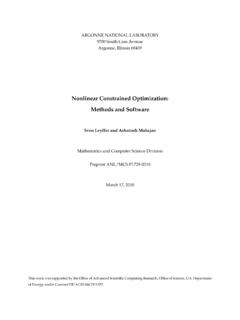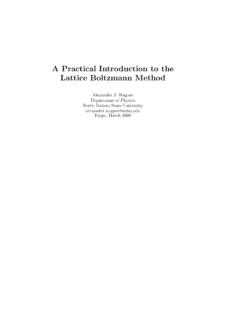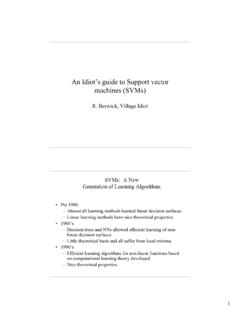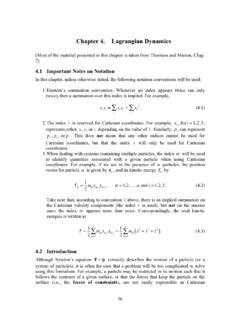Transcription of The Finite Element Method: Its Basis and Fundamentals
1 The Finite ElementMethod: Its Basis andFundamentalsSixth Zienkiewicz, CBE, FRSUNESCO Professor of Numerical methods in EngineeringInternational Centre for Numerical methods in Engineering, BarcelonaPreviously Director of the Institute for Numerical methods in EngineeringUniversity of Wales, ZhuProfessor in the Graduate SchoolSenior ScientistDepartment of Civil and Environmental EngineeringESI USR& of California at Berkeley5850 Waterloo Road, Suite 140 Berkeley, CaliforniaColumbia, MarylandAMSTERDAM BOSTON HEIDELBERG LONDON NEW YORK OXFORDPARIS SAN DIEGO SAN FRANCISCO SINGAPORE SYDNEY TOKYOE lsevier Butterworth-HeinemannLinacre House, Jordan Hill, Oxford OX2 8DP30 Corporate Drive, Burlington, MA 01803 First published in 1967 by McGraw-HillFifth edition published by Butterworth-Heinemann 2000 Reprinted 2002 Sixth edition 2005 Copyrightc 2000, 2005. Zienkiewicz, Taylor and Zhu. All rights reservedThe rights of Zienkiewicz, Taylor and Zhu to be identified as the authors of this workhave been asserted in accordance with the Copyright, Designs and Patents Act 1988No part of this publication may be reproduced in any material form (includingphotocopying or storing in any medium by electronic means and whether or nottransiently or incidentally to some other use of this publication) without the writtenpermission of the copyright holder except in accordance with the provisions of theCopyright, Designs and Patents Act 1988 or under the terms of a licence issued bythe Copyright Licensing Agency Ltd, 90, Tottenham Court Road, London,England W1T 4LP.
2 Applications for the copyright holder s written permissionto reproduce any part of this publication should be addressed to the may be sought directly from Elsevier s Science & TechnologyRights Department in Oxford, UK: phone: (+44) 1865 843830,fax: (+44) 1865 853333, e-mail: permissions @ You may alsocomplete your request on-line via the Elsevier homepage ( ),by selecting Customer Support and then Obtaining Permissions British Library Cataloguing in Publication DataA catalogue record for this book is available from the British LibraryLibrary of Congress Cataloguing in Publication DataA catalogue record for this book is available from the Library of CongressISBN 0 7506 6320 0 Published with the cooperation of CIMNE,the International Centre for Numerical methods in Engineering,Barcelona, Spain ( )For information on all Elsevier Butterworth-Heinemann publicationsvisit our website at by Kolam Information Services P Ltd, Pondicherry, IndiaDedicationThis book is dedicated to our wives Helen, Mary Lou andSong and our families for their support and patience duringthe preparation of this book, and also to all of our studentsand colleagues who over the years have contributed to ourknowledge of the Finite Element method.
3 In particular wewould like to mention Professor Eugenio O nate and hisgroup at CIMNE for their help, encouragement and supportduring the preparation is thirty-eight years since theThe Finite Element Method in Structural and ContinuumMechanicswas first published. This book, which was the first dealing with the finiteelement method, provided the Basis from which many further developments occurred. Theexpanding research and field of application of Finite elements led to the second edition in1971, the third in 1977, the fourth as two volumes in 1989 and 1991 and the fifth as threevolumes in 2000. The size of each of these editions expanded geometrically (from 272pages in 1967 to the fifth edition of 1482 pages). This was necessary to do justice to arapidly expanding field of professional application and research. Even so, much filteringof the contents was necessary to keep these editions within reasonable the present edition we have decided not to pursue the course of having three contiguousvolumes but rather we treat the whole work as an assembly of three separate works, eachone capable of being used without the others and each one appealing perhaps to a differentaudience.
4 Thoughnaturallywerecommendtheuseofthewho leensembletopeoplewishingto devote much of their time and study to the Finite Element particular the first volume which was entitledThe Finite Element Method: The Basisis now renamedThe Finite Element Method: Its Basis and Fundamentals . This volumehas been considerably reorganized from the previous one and is now, we believe, bettersuited for teaching Fundamentals of the Finite Element method. The sequence of chaptershas been somewhat altered and several examples of worked problems have been added tothe text. A set of problems to be worked out by students has also been addition to its previous content this book has been considerably enlarged by includingmore emphasis on use of higher order shape functions in formulation of problems and anew chapter devoted to the subject of automatic mesh generation. A beginner in the finiteelement field will find very rapidly that much of the work of solving problems consists ofpreparing a suitable mesh to deal with the whole problem and as the size of computers hasseemed to increase without limits the size of problems capable of being dealt with is alsoincreasing.
5 Thus, meshes containing sometimes more than several million nodes have to beprepared with details of the material interfaces, boundaries and loads being well are many books devoted exclusively to the subject of mesh generation but we feelthat the essence of dealing with this difficult problem should be included here for thosewho wish to have a complete encyclopedic knowledge of the chapter on computational methods is much reduced by transferring the computersource program and user instructions to a web site. This has the very substantial advantageof not only eliminating errors in program and manual but also in ensuring that the readershave the benefit of the most recent version of the program available at all two further volumes form again separate books and here we feel that a completelydifferent audience will use them. The first of these is entitledThe Finite Element Methodin Solid and Structural Mechanicsand the second is a text entitledThe Finite ElementMethod in Fluid Dynamics.
6 Each of these two volumes is a standalone text which providesthe full knowledge of the subject for those who have acquired an introduction to the finiteelement method through other texts. Of course the viewpoint of the authors introduced inthis volume will be continued but it is possible to start at a different emphasize here the fact that all three books stress the importance of considering thefinite Element method as a unique and whole Basis of approach and that it contains many ofthe other numerical analysis methods as special cases. Thus, imagination and knowledgeshould be combined by the readers in their authors are particularly indebted to the International Center of Numerical methods inEngineering (CIMNE) in Barcelona who have allowed their pre- and post-processing code(GiD) to be accessed from the web site. This allows such difficult tasks as mesh generationand graphic output to be dealt with efficiently. The authors are also grateful to ProfessorsEric Kasper and Jose Luis Perez-Aparicio for their careful scrutiny of the entire text andDrs Joaquim Peir o and Lee for their review of the new chapter on mesh to accompany this bookWorked solutions to selected problems in this book are available online for teachers andlecturers who either adopt or recommend the text.
7 Please visit and follow the registration and log in instructions on , RLT and JZZ Complete source code and user manual for programFEAP pvmay be obtained at no cost from the publisher sweb page: or from the authors web page: rltContentsPrefacexiii1 The standard discrete system and origins of the Finite Element The structural Element and the structural Assembly and analysis of a The boundary Electrical and fluid The general The standard discrete Transformation of Problems132 A direct physical approach to problems in elasticity: plane Direct formulation of Finite Element Generalization to the whole region internal nodal force Displacement approach as a minimization of total potential Convergence Discretization error and convergence Displacement functions with discontinuity between elements non-conforming elements and the patch Finite Element solution Numerical Concluding Problems473 Generalization of the Finite Element concepts.
8 Galerkin-weighted residual andvariational Integral or weak statements equivalent to the differential Approximation to integral formulations: the weighted residual-Galerkin Virtual work as the weak form of equilibrium equations for analysisof solids or Partial What are variational principles ? Natural variational principles and their relation to governingdifferential Establishment of natural variational principles for linear, self-adjoint,differential Maximum, minimum, or a saddle point? Constrained variational principles. Lagrange Constrained variational principles. Penalty function and perturbedlagrangian Least squares Concluding remarks Finite difference and boundary Problems974 Standard and hierarchical Element shape functions: some general Standard and hierarchical Rectangular elements some preliminary Completeness of Rectangular elements Lagrange Rectangular elements serendipity Triangular Element Line Rectangular prisms Lagrange Rectangular prisms serendipity Tetrahedral Other simple three-dimensional Hierarchic polynomials in one Two- and three-dimensional, hierarchical elements of the rectangle or brick Triangle and tetrahedron Improvement of conditioning with hierarchical Global and local Finite Element Elimination of internal parameters before assembly Concluding Problems1345 Mapped elements and numerical integration infinite and singularity elements Use of shape functions in the establishment of Geometrical conformity of Variation of the unknown function within distorted, curvilinearelements.
9 Continuity Evaluation of Element matrices. Transformation in , , coordinates Evaluation of Element matrices. Transformation in area and Order of convergence for mapped Shape functions by Numerical integration one Numerical integration rectangular (2D) or brick regions (3D) Numerical integration triangular or tetrahedral Required order of numerical Generation of Finite Element meshes by mapping. Blending functions Infinite domains and infinite Singular elements by mapping use in fracture mechanics, Computational advantage of numerically integrated Finite Problems1786 Problems in linear Governing Finite Element Reporting of results: displacements, strains and Numerical Problems2177 Field problems heat conduction, electric and magnetic potentialand fluid General quasi-harmonic Finite Element solution Partial discretization transient Numerical examples an assessment of Concluding Problems2538 Automatic mesh Two-dimensional mesh generation advancing front Surface mesh Three-dimensional mesh generation Delaunay Concluding Problems3239 The patch test, reduced integration, and non-conforming Convergence The simple patch test (tests A and B) a necessary condition Generalized patch test (test C)
10 And the single- Element The generality of a numerical patch Higher order patch Application of the patch test to plane elasticity elements with standard and reduced Application of the patch test to an incompatible Higher order patch test assessment of Concluding Problems35010 Mixed formulation and constraints complete field Discretization of mixed forms some general Stability of mixed approximation. The patch Two-field mixed formulation in Three-field mixed formulations in Complementary forms with direct Concluding remarks mixed formulation or a test of Element robustness Problems37911 Incompressible problems, mixed methods and other procedures of Deviatoric stress and strain, pressure and volume Two-field incompressible elasticity (u pform) Three-field nearly incompressible elasticity (u p vform) Reduced and selective integration and its equivalence to penalizedmixed A simple iterative solution process for mixed problems.






